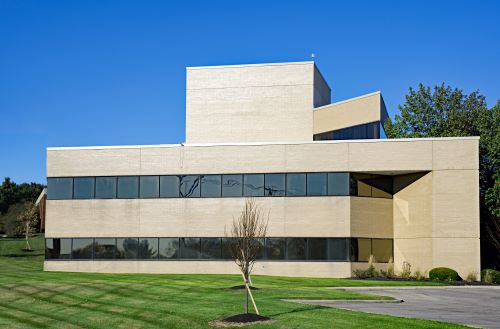The Perils of Ponding Water

Many commercial structures, such as office buildings, warehouses, and retail malls, are topped with a flat roof. Flat roofs are a much more cost-effective option than pitched roofs. Since structures that are built for commercial use are generally large and sometimes sprawling, it makes sense to use the most economical option when it’s time to put the roof on. A flat roof also allows the building owner to easily store and service air conditioning units, solar panels, or satellite dishes.
Even the flattest industrial roofing project in Kansas City isn’t completely flat. Commercial roofs still need to have a very slight slope to them to allow for proper drainage. So-called “flat” roofs must channel water in some fashion, so they’re built with a very slight slope either to the outside edges or into the center of the building. Gutters and drains then carry the water away just as they do on a residential roof.
Letting Water Stand Around
It’s not uncommon for a commercial flat roof to have standing water on it, especially after a heavy rain. The trouble starts if the water hangs around and doesn’t drain as it’s supposed to. This situation may arise because of issues with the slope of the roof or with the drainage system itself. Either way, if ponding water lingers after a rain or is discovered during a commercial roofing evaluation on your Kansas City property, you’ll want to get the underlying issue fixed. Standing water on a roof always spells trouble and may lead to much bigger – and more expensive – problems in the future.
What Happens if You Ignore It?
If water is still pooling on the roof after 48 hours of dry weather, you probably have an issue. The water is having trouble finding a place to drain. Since water moves toward any available outlet, it will move toward any cracks or fissures in the surface of the roof and attempt to drain through those openings. This means water may be leaking into places where it has no business – potentially into the ceiling below.
If drains and gutters are clogged, water may pool around vents, skylights, or other openings in the roof. Joints that aren’t tightly sealed around these extrusions may allow water to seep in, weakening the joints. It’s also possible that even if the seals are holding right now, just having a puddle of water around the joints can damage them, weakening the structure enough to create problems.
How to Eliminate Ponding Water
If you discover ponding water on your commercial roof, the best course of action is to call a commercial roofing contractor to come out and take a look at the situation. They’ll perform a commercial roofing evaluation on your Kansas City building to see where the issue lies. They’ll check the gutters, flashing, and drainage systems and will also check the roof for low spots. Since water always pools at the lowest spot, they’ll inspect the area where the water is ponding to make sure there’s nothing there that’s keeping the water from making its way to the drains properly.
Call in a Professional Commercial Roofing Contractor
Shamrock Roofing and Construction is a commercial roofing contractor specializing in industrial roofing needs throughout the Kansas City metro area. We’ve been in the roofing business for over 55 years and have the expertise to deal with ponding water, drainage issues, or any other commercial roofing challenge you have. Our roofers are well-versed in every type of commercial roofing system on the market and are familiar with the strengths and weaknesses of each. We’ll come out and perform a commercial roofing evaluation on your Kansas City property to see what’s causing the water to pool. Then we’ll recommend solutions to help you get the issue taken care of. Contact us today for solutions to all your commercial roofing problems.